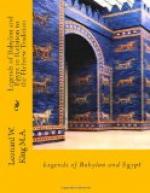The rest of the column may be taken as descriptive of Ziusudu’s activities. One line records his making of some very great object or the erection of a huge building;(1) and since the following lines are concerned solely with religious activities, the reference is possibly to a temple or some other structure of a sacred character. Its foundation may have been recorded as striking evidence of his devotion to his god; or, since the verb in this sentence depends on the words “at that time” in the preceding line, we may perhaps regard his action as directly connected with the revelation to be made to him. His personal piety is then described: daily he occupied himself in his god’s service, prostrating himself in humility and constant in his attendance at the shrine. A dream (or possibly dreams), “such as had not been before”, appears to him and he seems to be further described as conjuring “by the Name of Heaven and Earth”; but as the ends of all these lines are broken, the exact connexion of the phrases is not quite certain.
(1) The element gur-gur, “very large” or “huge”, which occurs in the name of this great object or building, an- sag-gur-gur, is employed later in the term for the “huge boat”, (gish)ma-gur-gur, in which Ziusudu rode out the storm. There was, of course, even at this early period a natural tendency to picture on a superhuman scale the lives and deeds of remote predecessors, a tendency which increased in later times and led, as we shall see, to the elaboration of extravagant detail.
It is difficult not to associate the reference to a dream, or possibly to dream-divination, with the warning in which Enki reveals the purpose of the gods. For the later versions prepare us for a reference to a dream. If we take the line as describing Ziusudu’s practice of dream-divination in general, “such as had not been before”, he may have been represented as the first diviner of dreams, as Enmeduranki was held to be the first practitioner of divination in general. But it seems to me more probable that the reference is to a particular dream, by means of which he obtained knowledge of the gods’ intentions. On the rendering of this passage depends our interpretation of the whole of the Fourth Column, where the point will be further discussed. Meanwhile it may be noted that the conjuring “by the Name of Heaven and Earth”, which we may assume is ascribed to Ziusudu, gains in significance if we may regard the setting of the myth as a magical incantation, an inference in support of which we shall note further evidence. For we are furnished at once with the grounds for its magical employment. If Ziusudu, through conjuring by the Name of Heaven and earth, could profit by the warning sent him and so escape the impending fate of mankind, the application of such a myth to the special needs of a Sumerian in peril or distress will be obvious. For should he, too, conjure by the Name of Heaven and Earth, he might look for a similar deliverance; and his recital of the myth itself would tend to clinch the magical effect of his own incantation.




